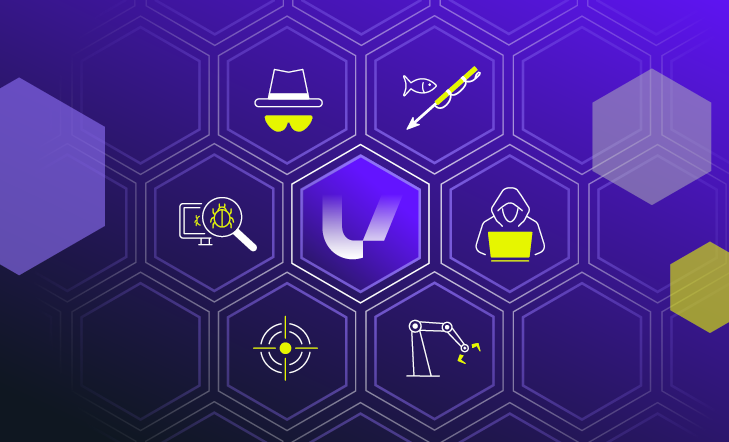
Akira Ransomware Threat Actors Observed Targeting Cisco ASA SSL VPNs with Credential Stuffing Attacks
Akira Ransomware Threat Actors Observed Targeting Cisco ASA SSL VPNs with Credential Stuffing Attacks
Find flaws in web, mobile, and IoT applications.
Expose risks in AWS, Azure, and GCP environments.
Ongoing testing to catch real-world vulnerabilities as they appear.
Live-fire exercises to sharpen detection and response.
Time-boxed security assessments across networks, apps, and infrastructure.
Simulated attacks to test detection and incident response.
Named security experts integrated seamlessly into your team.
Real-time detection and automated threat response.
24x7 monitoring and response by expert analysts.
Nonstop scanning to prioritize and reduce risk.
Ongoing scanning, triage, and compliance tracking.
Unified security platform powering all UV services.
Cross-platform toolkit for advanced red team ops.

Secure your code, infrastructure, and deployment pipelines before attackers exploit them.
September 19, 2025
August 27, 2025
June 26, 2025
UltraViolet Cyber is a practitioner-led MSSP delivering offensive and defensive security to Global 2000 and Federal clients. Built by former intelligence operators, we unify application security, red teaming, detection, and engineering under one roof. Our UV Lens platform replaces silos with integrated, outcome-driven operations.
UltraViolet Cyber
July 18, 2023
Achieving robust security in the cloud is a matter of visibility.
While AWS offers unique opportunities and benefits as a cloud platform, it also presents challenges that demand our attention. Are we prioritizing a security strategy over controls and tools?
As the cloud ecosystem expands, so do the security risks. The top concerns include misconfigurations, insecure interfaces, and unauthorized access. The rapid proliferation of applications and data in the cloud, driven by digital transformation and IT consumerization, exposes organizations to the dangers of unmonitored access, security vulnerabilities, and data leaks.
One major security challenge is the lack of visibility into cloud usage within organizations. To address this, many enterprises are reevaluating and adapting their security postures to suit the dynamic nature of cloud environments. Surprisingly, the average enterprise invests in 32 different cloud security tools, incurring substantial costs.
Finding qualified cybersecurity expertise is another significant hurdle faced by organizations struggling with the shortage of cloud security skills. These challenges highlight the need for businesses to answer key questions:
According to the recent global Cloud Security Report by Check Point and Cybersecurity Insiders, the primary cloud security threats are unauthorized cloud access, insecure interfaces, misconfigurations of the cloud platform, and account hijacking.
It's important to recognize that AWS security is not fail-safe and operates on a Shared Security Responsibility model. While Amazon secures its infrastructure, you are responsible for implementing your own security controls for the data and applications you deploy and store in the cloud.
.png?width=625&height=375&name=MicrosoftTeams-image%20(22).png)
RedLock's research reveals that the average lifespan of a cloud resource is a mere two hours and seven minutes. With multiple cloud accounts and regions, detecting risks becomes challenging due to decentralized visibility. Shockingly, 85% of resources associated with security groups do not restrict outbound traffic at all.
Administrators often forget to disable root API access, and the exposed application structure necessitates reinforcing existing security controls. This includes regularly updating security configurations, applying patches, implementing strong firewall configurations, and ensuring proper network security measures.
AWS S3 buckets pose new security blind spots as they become accessible through additional channels and APIs, creating opportunities for hackers to exploit vulnerabilities.
AWS infrastructure configuration issues, as highlighted by ScienceSoft's research, include concerns with AWS Firewall Manager, identity and access management (IAM) controls, and logging and monitoring tools (Amazon GuardDuty, CloudWatch, and CloudTrail). Typical misconfigurations within these components encompass disabled multi-factor authentication, inadequate logging of API call history, wide-ranging permissions for S3 buckets and cloud storage resources, overprivileged IAM accounts, overly permissive AWS Security Groups, insecure startup and configuration scripts, public AWS AMIs containing sensitive data, and public storage of machine state snapshots.
At UltraViolet Cyber, our comprehensive Cloud Security Services offer real-time monitoring, ensuring complete visibility of applications, devices, and servers in the cloud. Our team of Cybersecurity Practitioners, Professional Services (PS), Security Specialists, and DevOps experts can enhance monitoring, compliance, and response by centralizing control over all cloud workloads, including IaaS, PaaS, containers, and virtual environments. Additionally, we conduct penetration testing as part of our security testing services.
As part of our Managed Cloud Security services, we leverage AWS native tools such as Security Hub, Trusted Advisor, Route53, WAF, Kinesis, GuardDuty, CloudTrail, CloudWatch, Macie, MFA, Inspector, DDOS mitigation, IAM, Data Encryption, and Infra security to provide holistic AWS cloud security.
Our team of cloud security experts is always available to discuss your company's unique needs and goals for seamless security implementation. Contact us today to ensure your AWS cloud security remains robust and effective.
The five security issues relating to cloud computing are data breaches and leaks, insecure APIs, misconfigured cloud services, lack of visibility and control, and shared resource vulnerabilities. These issues can lead to unauthorized access, data loss, and compliance violations, emphasizing the need for robust cloud security measures.
One of the biggest challenges in AWS is managing costs effectively. The dynamic and scalable nature of cloud resources can lead to unexpected expenses if not carefully monitored and optimized. Organizations must implement cost management strategies, leverage AWS cost tools, and continuously monitor resource usage to control cloud spending efficiently.
To ensure security for enterprise networks, consider implementing the following five practices:
Network Segmentation: Divide the network into smaller segments with restricted access to limit the impact of breaches and unauthorized access.
Strong Access Controls: Implement robust authentication and authorization mechanisms to control user access to sensitive resources and data.
Regular Patching and Updates: Keep all network devices, software, and systems up to date with the latest security patches to prevent known vulnerabilities from being exploited.
Network Monitoring and Logging: Employ continuous monitoring and logging to detect suspicious activities and promptly respond to potential security incidents.
Employee Training and Awareness: Train employees on security best practices, including phishing awareness and secure use of network resources, to reduce the risk of human-related security incidents.
We’re here to help. Get in touch for an initial conversation with one of our security experts and learn more about how UltraViolet Cyber can help you take cyber readiness and resilience to new levels.